Cover
Title Page
Copyright Page
Contents
Preface
Acknowledgments
The Book Web Site
About the Authors
1 Introduction
1.1 What Is Digital Image Processing?
1.2 The Origins of Digital Image Processing
1.3 Examples of Fields that Use Digital Image Processing
1.3.1 Gamma-Ray Imaging
1.3.2 X-Ray Imaging
1.3.3 Imaging in the Ultraviolet Band
1.3.4 Imaging in the Visible and Infrared Bands
1.3.5 Imaging in the Microwave Band
1.3.6 Imaging in the Radio Band
1.3.7 Examples in which Other Imaging Modalities Are Used
1.4 Fundamental Steps in Digital Image Processing
1.5 Components of an Image Processing System
Summary
References and Further Reading
2 Digital Image Fundamentals
2.1 Elements of Visual Perception
2.1.1 Structure of the Human Eye
2.1.2 Image Formation in the Eye
2.1.3 Brightness Adaptation and Discrimination
2.2 Light and the Electromagnetic Spectrum
2.3 Image Sensing and Acquisition
2.3.1 Image Acquisition Using a Single Sensor
2.3.2 Image Acquisition Using Sensor Strips
2.3.3 Image Acquisition Using Sensor Arrays
2.3.4 A Simple Image Formation Model
2.4 Image Sampling and Quantization
2.4.1 Basic Concepts in Sampling and Quantization
2.4.2 Representing Digital Images
2.4.3 Spatial and Intensity Resolution
2.4.4 Image Interpolation
2.5 Some Basic Relationships between Pixels
2.5.1 Neighbors of a Pixel
2.5.2 Adjacency, Connectivity, Regions, and Boundaries
2.5.3 Distance Measures
2.6 An Introduction to the Mathematical Tools Used in Digital Image Processing
2.6.1 Array versus Matrix Operations
2.6.2 Linear versus Nonlinear Operations
2.6.3 Arithmetic Operations
2.6.4 Set and Logical Operations
2.6.5 Spatial Operations
2.6.6 Vector and Matrix Operations
2.6.7 Image Transforms
2.6.8 Probabilistic Methods
Summary
References and Further Reading
Problems
3 Intensity Transformations and Spatial Filtering
3.1 Background
3.1.1 The Basics of Intensity Transformations and Spatial Filtering
3.1.2 About the Examples in This Chapter
3.2 Some Basic Intensity Transformation Functions
3.2.1 Image Negatives
3.2.2 Log Transformations
3.2.3 Power-Law (Gamma) Transformations
3.2.4 Piecewise-Linear Transformation Functions
3.3 Histogram Processing
3.3.1 Histogram Equalization
3.3.2 Histogram Matching (Specification)
3.3.3 Local Histogram Processing
3.3.4 Using Histogram Statistics for Image Enhancement
3.4 Fundamentals of Spatial Filtering
3.4.1 The Mechanics of Spatial Filtering
3.4.2 Spatial Correlation and Convolution
3.4.3 Vector Representation of Linear Filtering
3.4.4 Generating Spatial Filter Masks
3.5 Smoothing Spatial Filters
3.5.1 Smoothing Linear Filters
3.5.2 Order-Statistic (Nonlinear) Filters
3.6 Sharpening Spatial Filters
3.6.1 Foundation
3.6.2 Using the Second Derivative for Image Sharpening—The Laplacian
3.6.3 Unsharp Masking and Highboost Filtering
3.6.4 Using First-Order Derivatives for (Nonlinear) Image Sharpening—The Gradient
3.7 Combining Spatial Enhancement Methods
3.8 Using Fuzzy Techniques for Intensity Transformations and Spatial Filtering
3.8.1 Introduction
3.8.2 Principles of Fuzzy Set Theory
3.8.3 Using Fuzzy Sets
3.8.4 Using Fuzzy Sets for Intensity Transformations
3.8.5 Using Fuzzy Sets for Spatial Filtering
Summary
References and Further Reading
Problems
4 Filtering in the Frequency Domain
4.1 Background
4.1.1 A Brief History of the Fourier Series and Transform
4.1.2 About the Examples in this Chapter
4.2 Preliminary Concepts
4.2.1 Complex Numbers
4.2.2 Fourier Series
4.2.3 Impulses and Their Sifting Property
4.2.4 The Fourier Transform of Functions of One Continuous Variable
4.2.5 Convolution
4.3 Sampling and the Fourier Transform of Sampled Functions
4.3.1 Sampling
4.3.2 The Fourier Transform of Sampled Functions
4.3.3 The Sampling Theorem
4.3.4 Aliasing
4.3.5 Function Reconstruction (Recovery) from Sampled Data
4.4 The Discrete Fourier Transform (DFT) of One Variable
4.4.1 Obtaining the DFT from the Continuous Transform of a Sampled Function
4.4.2 Relationship Between the Sampling and Frequency Intervals
4.5 Extension to Functions of Two Variables
4.5.1 The 2-D Impulse and Its Sifting Property
4.5.2 The 2-D Continuous Fourier Transform Pair
4.5.3 Two-Dimensional Sampling and the 2-D Sampling Theorem
4.5.4 Aliasing in Images
4.5.5 The 2-D Discrete Fourier Transform and Its Inverse
4.6 Some Properties of the 2-D Discrete Fourier Transform
4.6.1 Relationships Between Spatial and Frequency Intervals
4.6.2 Translation and Rotation
4.6.3 Periodicity
4.6.4 Symmetry Properties
4.6.5 Fourier Spectrum and Phase Angle
4.6.6 The 2-D Convolution Theorem
4.6.7 Summary of 2-D Discrete Fourier Transform Properties
4.7 The Basics of Filtering in the Frequency Domain
4.7.1 Additional Characteristics of the Frequency Domain
4.7.2 Frequency Domain Filtering Fundamentals
4.7.3 Summary of Steps for Filtering in the Frequency Domain
4.7.4 Correspondence Between Filtering in the Spatial and Frequency Domains
4.8 Image Smoothing Using Frequency Domain Filters
4.8.1 Ideal Lowpass Filters
4.8.2 Butterworth Lowpass Filters
4.8.3 Gaussian Lowpass Filters
4.8.4 Additional Examples of Lowpass Filtering
4.9 Image Sharpening Using Frequency Domain Filters
4.9.1 Ideal Highpass Filters
4.9.2 Butterworth Highpass Filters
4.9.3 Gaussian Highpass Filters
4.9.4 The Laplacian in the Frequency Domain
4.9.5 Unsharp Masking, Highboost Filtering, and High-Frequency- Emphasis Filtering
4.9.6 Homomorphic Filtering
4.10 Selective Filtering
4.10.1 Bandreject and Bandpass Filters
4.10.2 Notch Filters
4.11 Implementation
4.11.1 Separability of the 2-D DFT
4.11.2 Computing the IDFT Using a DFT Algorithm
4.11.3 The Fast Fourier Transform (FFT)
4.11.4 Some Comments on Filter Design
Summary
References and Further Reading
Problems
5 Image Restoration and Reconstruction
5.1 A Model of the Image Degradation/Restoration Process
5.2 Noise Models
5.2.1 Spatial and Frequency Properties of Noise
5.2.2 Some Important Noise Probability Density Functions
5.2.3 Periodic Noise
5.2.4 Estimation of Noise Parameters
5.3 Restoration in the Presence of Noise Only—Spatial Filtering
5.3.1 Mean Filters
5.3.2 Order-Statistic Filters
5.3.3 Adaptive Filters
5.4 Periodic Noise Reduction by Frequency Domain Filtering
5.4.1 Bandreject Filters
5.4.2 Bandpass Filters
5.4.3 Notch Filters
5.4.4 Optimum Notch Filtering
5.5 Linear, Position-Invariant Degradations
5.6 Estimating the Degradation Function
5.6.1 Estimation by Image Observation
5.6.2 Estimation by Experimentation
5.6.3 Estimation by Modeling
5.7 Inverse Filtering
5.8 Minimum Mean Square Error (Wiener) Filtering
5.9 Constrained Least Squares Filtering
5.10 Geometric Mean Filter
5.11 Image Reconstruction from Projections
5.11.1 Introduction
5.11.2 Principles of Computed Tomography (CT)
5.11.3 Projections and the Radon Transform
5.11.4 The Fourier-Slice Theorem
5.11.5 Reconstruction Using Parallel-Beam Filtered Backprojections
5.11.6 Reconstruction Using Fan-Beam Filtered Backprojections
Summary
References and Further Reading
Problems
6 Color Image Processing
6.1 Color Fundamentals
6.2 Color Models
6.2.1 The RGB Color Model
6.2.2 The CMY and CMYK Color Models
6.2.3 The HSI Color Model
6.3 Pseudocolor Image Processing
6.3.1 Intensity Slicing
6.3.2 Intensity to Color Transformations
6.4 Basics of Full-Color Image Processing
6.5 Color Transformations
6.5.1 Formulation
6.5.2 Color Complements
6.5.3 Color Slicing
6.5.4 Tone and Color Corrections
6.5.5 Histogram Processing
6.6 Smoothing and Sharpening
6.6.1 Color Image Smoothing
6.6.2 Color Image Sharpening
6.7 Image Segmentation Based on Color
6.7.1 Segmentation in HSI Color Space
6.7.2 Segmentation in RGB Vector Space
6.7.3 Color Edge Detection
6.8 Noise in Color Images
6.9 Color Image Compression
Summary
References and Further Reading
Problems
7 Wavelets and Multiresolution Processing
7.1 Background
7.1.1 Image Pyramids
7.1.2 Subband Coding
7.1.3 The Haar Transform
7.2 Multiresolution Expansions
7.2.1 Series Expansions
7.2.2 Scaling Functions
7.2.3 Wavelet Functions
7.3 Wavelet Transforms in One Dimension
7.3.1 The Wavelet Series Expansions
7.3.2 The Discrete Wavelet Transform
7.3.3 The Continuous Wavelet Transform
7.4 The Fast Wavelet Transform
7.5 Wavelet Transforms in Two Dimensions
7.6 Wavelet Packets
Summary
References and Further Reading
Problems
8 Image Compression
8.1 Fundamentals
8.1.1 Coding Redundancy
8.1.2 Spatial and Temporal Redundancy
8.1.3 Irrelevant Information
8.1.4 Measuring Image Information
8.1.5 Fidelity Criteria
8.1.6 Image Compression Models
8.1.7 Image Formats, Containers, and Compression Standards
8.2 Some Basic Compression Methods
8.2.1 Huffman Coding
8.2.2 Golomb Coding
8.2.3 Arithmetic Coding
8.2.4 LZW Coding
8.2.5 Run-Length Coding
8.2.6 Symbol-Based Coding
8.2.7 Bit-Plane Coding
8.2.8 Block Transform Coding
8.2.9 Predictive Coding
8.2.10 Wavelet Coding
8.3 Digital Image Watermarking
Summary
References and Further Reading
Problems
9 Morphological Image Processing
9.1 Preliminaries
9.2 Erosion and Dilation
9.2.1 Erosion
9.2.2 Dilation
9.2.3 Duality
9.3 Opening and Closing
9.4 The Hit-or-Miss Transformation
9.5 Some Basic Morphological Algorithms
9.5.1 Boundary Extraction
9.5.2 Hole Filling
9.5.3 Extraction of Connected Components
9.5.4 Convex Hull
9.5.5 Thinning
9.5.6 Thickening
9.5.7 Skeletons
9.5.8 Pruning
9.5.9 Morphological Reconstruction
9.5.10 Summary of Morphological Operations on Binary Images
9.6 Gray-Scale Morphology
9.6.1 Erosion and Dilation
9.6.2 Opening and Closing
9.6.3 Some Basic Gray-Scale Morphological Algorithms
9.6.4 Gray-Scale Morphological Reconstruction
Summary
References and Further Reading
Problems
10 Image Segmentation
10.1 Fundamentals
10.2 Point, Line, and Edge Detection
10.2.1 Background
10.2.2 Detection of Isolated Points
10.2.3 Line Detection
10.2.4 Edge Models
10.2.5 Basic Edge Detection
10.2.6 More Advanced Techniques for Edge Detection
10.2.7 Edge Linking and Boundary Detection
10.3 Thresholding
10.3.1 Foundation
10.3.2 Basic Global Thresholding
10.3.3 Optimum Global Thresholding Using Otsu’s Method
10.3.4 Using Image Smoothing to Improve Global Thresholding
10.3.5 Using Edges to Improve Global Thresholding
10.3.6 Multiple Thresholds
10.3.7 Variable Thresholding
10.3.8 Multivariable Thresholding
10.4 Region-Based Segmentation
10.4.1 Region Growing
10.4.2 Region Splitting and Merging
10.5 Segmentation Using Morphological Watersheds
10.5.1 Background
10.5.2 Dam Construction
10.5.3 Watershed Segmentation Algorithm
10.5.4 The Use of Markers
10.6 The Use of Motion in Segmentation
10.6.1 Spatial Techniques
10.6.2 Frequency Domain Techniques
Summary
References and Further Reading
Problems
11 Representation and Description
11.1 Representation
11.1.1 Boundary (Border) Following
11.1.2 Chain Codes
11.1.3 Polygonal Approximations Using Minimum-Perimeter Polygons
11.1.4 Other Polygonal Approximation Approaches
11.1.5 Signatures
11.1.6 Boundary Segments
11.1.7 Skeletons
11.2 Boundary Descriptors
11.2.1 Some Simple Descriptors
11.2.2 Shape Numbers
11.2.3 Fourier Descriptors
11.2.4 Statistical Moments
11.3 Regional Descriptors
11.3.1 Some Simple Descriptors
11.3.2 Topological Descriptors
11.3.3 Texture
11.3.4 Moment Invariants
11.4 Use of Principal Components for Description
11.5 Relational Descriptors
Summary
References and Further Reading
Problems
12 Object Recognition
12.1 Patterns and Pattern Classes
12.2 Recognition Based on Decision-Theoretic Methods
12.2.1 Matching
12.2.2 Optimum Statistical Classifiers
12.2.3 Neural Networks
12.3 Structural Methods
12.3.1 Matching Shape Numbers
12.3.2 String Matching
Summary
References and Further Reading
Problems
Appendix A
Bibliography
Index
A
B
C
D
E
F
G
H
I
J
L
M
N
O
P
Q
R
S
T
U
V
W
X
Z
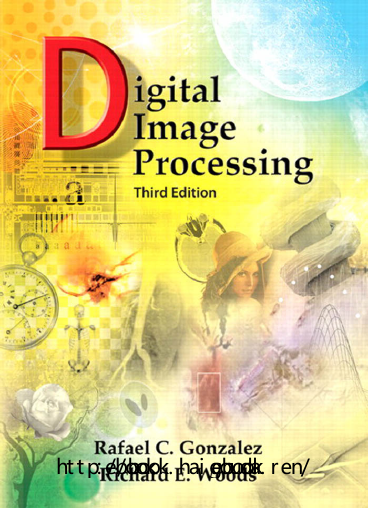

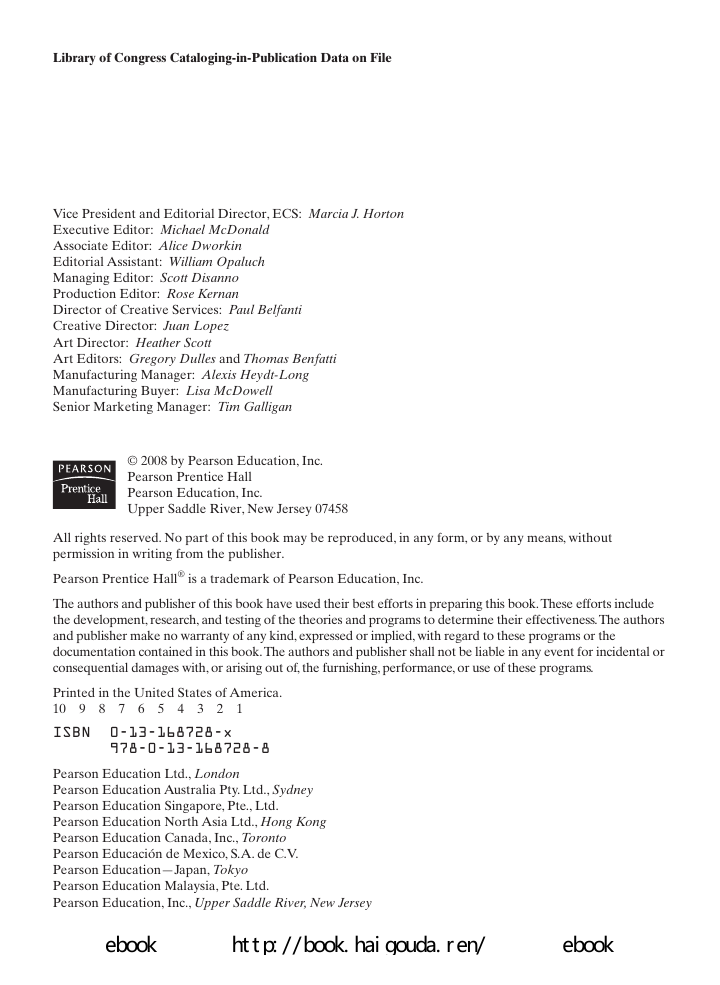
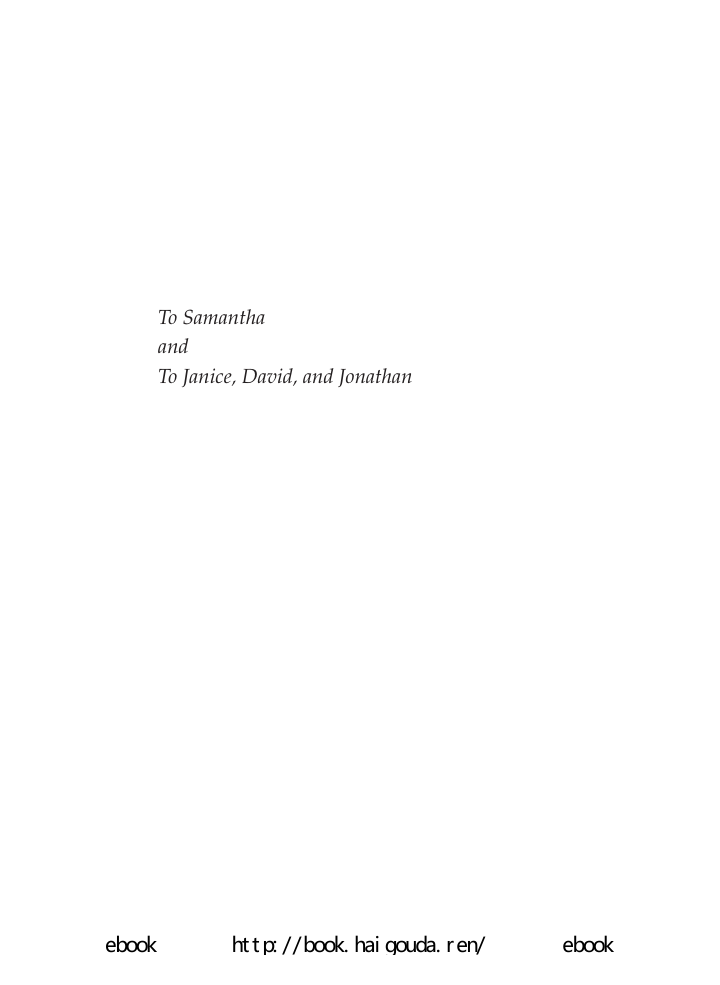

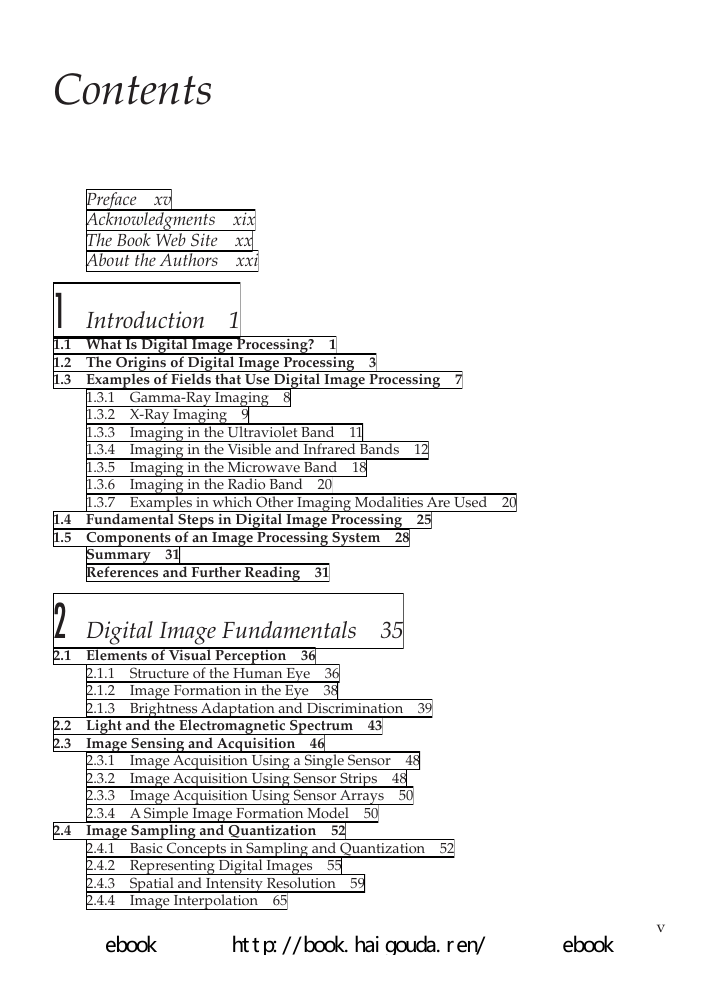

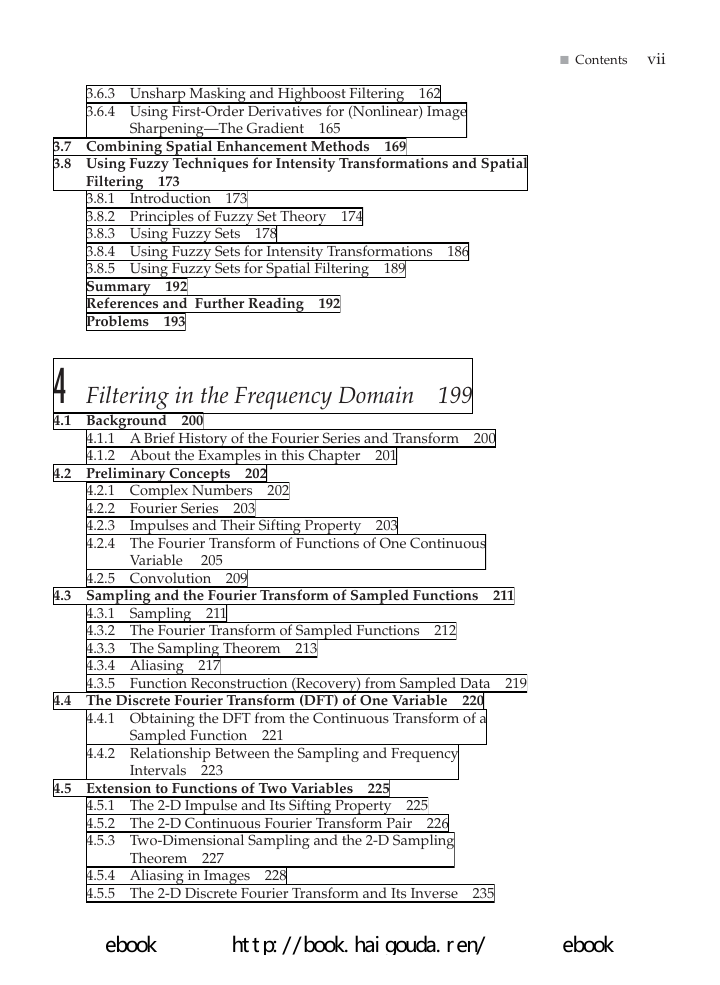








 2023年江西萍乡中考道德与法治真题及答案.doc
2023年江西萍乡中考道德与法治真题及答案.doc 2012年重庆南川中考生物真题及答案.doc
2012年重庆南川中考生物真题及答案.doc 2013年江西师范大学地理学综合及文艺理论基础考研真题.doc
2013年江西师范大学地理学综合及文艺理论基础考研真题.doc 2020年四川甘孜小升初语文真题及答案I卷.doc
2020年四川甘孜小升初语文真题及答案I卷.doc 2020年注册岩土工程师专业基础考试真题及答案.doc
2020年注册岩土工程师专业基础考试真题及答案.doc 2023-2024学年福建省厦门市九年级上学期数学月考试题及答案.doc
2023-2024学年福建省厦门市九年级上学期数学月考试题及答案.doc 2021-2022学年辽宁省沈阳市大东区九年级上学期语文期末试题及答案.doc
2021-2022学年辽宁省沈阳市大东区九年级上学期语文期末试题及答案.doc 2022-2023学年北京东城区初三第一学期物理期末试卷及答案.doc
2022-2023学年北京东城区初三第一学期物理期末试卷及答案.doc 2018上半年江西教师资格初中地理学科知识与教学能力真题及答案.doc
2018上半年江西教师资格初中地理学科知识与教学能力真题及答案.doc 2012年河北国家公务员申论考试真题及答案-省级.doc
2012年河北国家公务员申论考试真题及答案-省级.doc 2020-2021学年江苏省扬州市江都区邵樊片九年级上学期数学第一次质量检测试题及答案.doc
2020-2021学年江苏省扬州市江都区邵樊片九年级上学期数学第一次质量检测试题及答案.doc 2022下半年黑龙江教师资格证中学综合素质真题及答案.doc
2022下半年黑龙江教师资格证中学综合素质真题及答案.doc